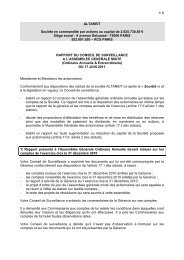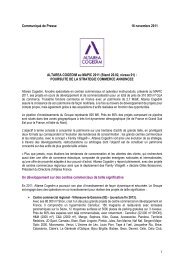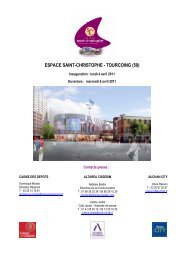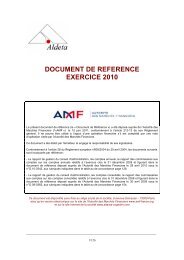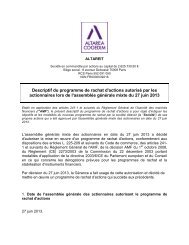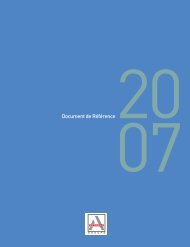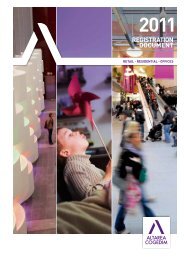Annual report 2008 - Altarea Cogedim
Annual report 2008 - Altarea Cogedim
Annual report 2008 - Altarea Cogedim
Create successful ePaper yourself
Turn your PDF publications into a flip-book with our unique Google optimized e-Paper software.
CONSOLIDATED FINANCIAL STATEMENTS<br />
7.15 Remeasurement of non-current<br />
assets (other than financial assets<br />
and investment properties)<br />
Tangible assets and intangible assets subject to amortisation<br />
are tested for impairment whenever any internal or external<br />
evidence of impairment is observed.<br />
Goodwill and other intangible assets with an indeterminate<br />
life, such as brands, are systematically tested for impairment<br />
annually or more frequently if internal or external events or<br />
circumstances indicate that their value may have declined.<br />
The carrying amount of such assets is compared with the<br />
recoverable amount, defined as the higher of the selling<br />
price net of costs to sell and value in use.<br />
The value in use of a CGU is determined by the discounted<br />
cash flow (DCF) method based on the following principles:<br />
• the cash flows (before tax) are taken from five-year business<br />
plans drawn up by group management;<br />
• the discount rate is determined on the basis of a weighted<br />
average cost of capital;<br />
• terminal value is calculated as the sum to infinity of<br />
the discounted cash flows, which are determined on the<br />
basis of a normalised cash flow and a growth rate for<br />
the activity concerned. The assumed growth rate must<br />
be consistent with the growth potential of the markets<br />
in which the activity is conducted, as well as with the<br />
entity’s competitive position in those markets.<br />
The recoverable amount of the cash-generating unit<br />
determined by this procedure is then compared with the<br />
consolidated carrying amount of its assets (including any<br />
goodwill) and liabilities.<br />
An impairment loss is recognised if the carrying amount<br />
on the balance sheet is greater than the CGU’s recoverable<br />
amount. The impairment loss is allocated first to goodwill<br />
and then to other tangible and intangible assets in proportion<br />
to their individual carrying amounts. The impairment thus<br />
recognised is reversible, except for any portion charged to<br />
goodwill.<br />
7.16. Inventories<br />
Within the ALTAREA group, inventories relate to the business<br />
of:<br />
• property development for third parties and the portion of<br />
shopping centre development not intended to be held in<br />
ALTAREA’s portfolio (hypermarket building shells, parking<br />
facilities, etc.);<br />
• transactions where the nature or specific administrative<br />
situation of the project prompts a decision to classify<br />
them as inventory (dealer’s stock) or where a final decision<br />
to hold them in the portfolio has not been made.<br />
Inventories and work in progress consist of design and<br />
programme management fees, land valued at acquisition<br />
cost, work in progress (grading and construction) and<br />
finished goods valued at production cost.<br />
Finance costs attributable to programmes are included in<br />
inventories as optionally allowed under the revised IAS 23.<br />
“New transactions” correspond to programmes not yet<br />
developed. These programmes are stated at cost and<br />
include the cost of pre-launch design studies (design and<br />
management fees), as well as earnest and option deposits<br />
put down to acquire land. These outlays are capitalised if the<br />
probabilities of completing the transaction are high. If not,<br />
these costs are expensed as incurred. At the balance sheet<br />
date, a review is conducted of these “new transactions”<br />
and if completion of the transaction is uncertain, the costs<br />
incurred are expensed.<br />
“Construction work in progress” transactions are carried<br />
at production cost less the portion of cost retired on a<br />
percentage-of-completion basis for off-plan sale (VEFA) or<br />
property development contract transactions (see also Note<br />
7.24). Production cost includes the acquisition cost of land,<br />
the construction costs (inclusive of road and utilities works),<br />
technical and programme management fees, programme<br />
marketing fees and sales commissions, advertising expenses<br />
directly related to programmes and other related expenses.<br />
Management fees for services performed within the Group<br />
are reduced by the amount of the profit margin, which is<br />
eliminated on consolidation.<br />
“Completed transactions” consist of lots remaining to be<br />
sold once the declaration of completion has been filed. An<br />
impairment loss is recognised whenever realisable value net<br />
of marketing costs is less than the carrying amount.<br />
Whenever the net realisable value of inventories and work in<br />
progress is less than the production cost, impairment losses<br />
are recognised.<br />
92



